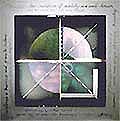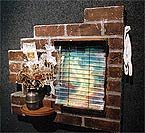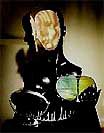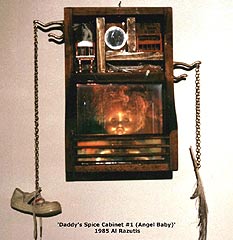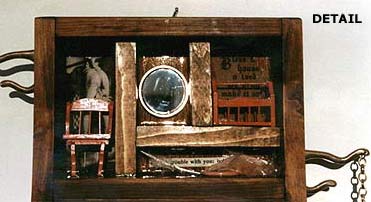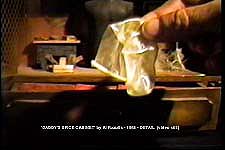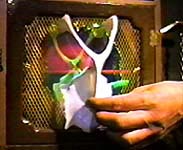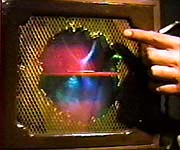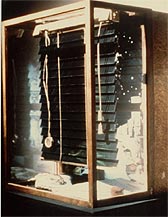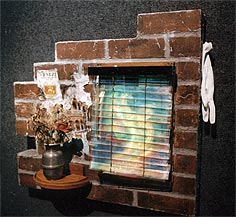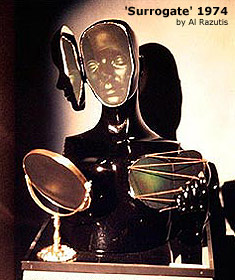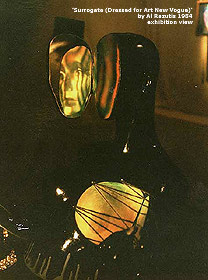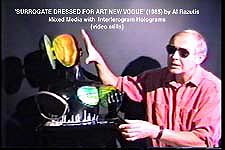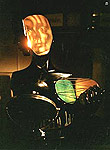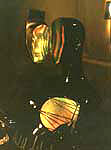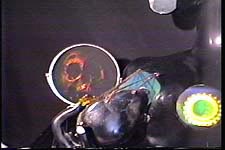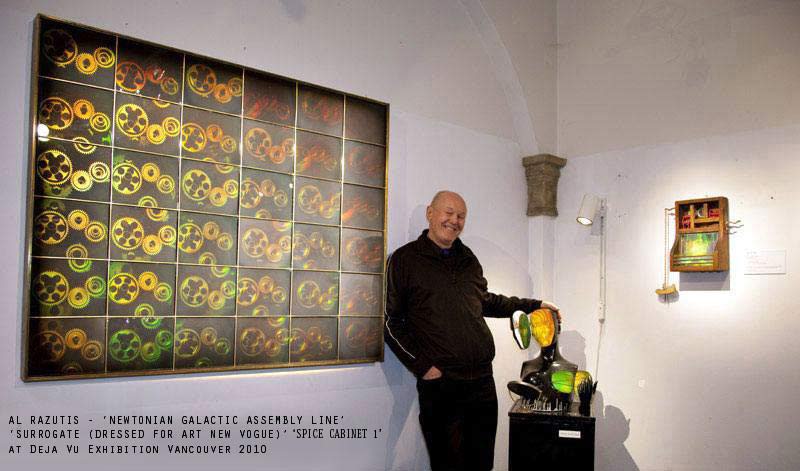Holographic 'Hybrids' and 'Surrogates' in the Art of Holography
Essay, Holography and art by Al Razutis
Holographic and sculptural art by Al Razutis -- 2004-2005 essay, including 2010 Exhibition photos.
|
"
The combination of the surreal and the real creates a dialogue about what is 'real', how images occupy memory, how solid and immaterial exchange places. The framed, installed, sculpted results of these 'hybrids' is one of the early accomplishments of a new art medium like holography asserting its place beyond its predecessor art forms - beyond, but not disconnected.
"
-- AR, 2005 |
These works have been on exhibit internationally since the 1970's and 1980's.
Of particular interest to curators, historians and collectors will be the essay "Some Notes on the Art of Holography" by Al Razutis
which appeared in the exhibition catalog on pages 23-26, Franklin Institute Press, for the 1979 Franklin Institute Exhibition 'New Spaces - The Holographer's vision'
(Link to essay on 'hybrids' and exhibition contexts.)
|
HOLOGRAPHIC WORKS IN STEREO 3D ON YOUTUBE |
2021 Essay by Razutis concerning surrealism and holography: 3D or not 3D? Dalinian Space and Holographic Space'
|
TERMS AND POESIS Holographic 'hybrids' is a term used by Al Razutis starting in the 1970's to identify the combination of sculpture (original or found-object assemblage) and holograms/holographic images and their resulting 'hybrid' aesthetics (holographic, post-modern, modern, classical). The sculptural nature of the holographic (virtual or real) image, the fact that it occupies 'space' and displays 'object' characteristics (size, proportion, perspective, depth), the fact that the holographic image 'floats' and is free from 'gravity' are paradoxical and poetic to those who pursue the surrealisms of 'phantasmic objects' and the 'marvelous', or kitsch and post-modern commentary/construction. In other words, these works are not about parlor 'magic' illusions but a 'dance with phantasms' and memory, cultural and personal. 
This seeminly 'illogical' condition (an object floating, free from gravity) has been inspirational to generations of holographic artists. It is of course related to a fascination with 'magic' (illusions, levitations) and of course has been trivialized by some trinket manufacturers to entice a audience interested in buying novelties ('how did they do that?'). It is also related to the 'marvelous' contained in surrealist works, but this relation is also a point of departure. It is no longer that the holographic 'image' is complete in and of itself, but that the work refers to the holographic 'image' in relation to its 'container' or physical counterpart (the sculpture, or installation). In Razutis' works, the holographic hybrids can be allegorical, narrative, surrealist, didactic or metaphysical and alchemical notations. In his early essay, Some Notes on the Art of Holography (1979, Franklin Institute Press), Razutis provides a lengthy description of 'hybrid' holography in terms of didacticism, surrealism and the limitations of 'mimetic' or 'display' holographic aesthetics.
ENIGMAS AND 'EFFIGIES':The holographic image is part enigma, part physical science. It is enigmatic to artists who, upon discovering a effigy of an object suspended behind the plate, or projecting in front of the plate, in space, are dissatisfied with mere 'physical' explanations (diffraction, geomteric optics) and wish to participate in the creations of a 'marvelous' alternative to physical representation. Just think: to 'refashion the real' in ways that were previously impossible. In ways that combines traces of 'both real and unreal'. And some of the works arising from these impulses are didactic: they comment on 'the real' by creating 'unreal containers for the real', or conversely 'the unreal contained within the real'. SURREALIST 'MARVELOUS' CAUGHT IN THE REFLECTION...
Andre Breton's essay "Crisis of the Object" (1936) drew analogies between "concrete irrationality" in art with qualities of "mathematical objects", "poetic objects" and objects appearing in dreams. The surrealist war against surface representation was an attempt to liberate the imagination from habit and convention, to encourage one to seek meaning beneath the surface. Breton's convictions were that "there is more to be found in the hidden real than in the immediate known quantity". To attack the habitual is to "make it strange". To revitalize our sense of life and the 'real' is to enploy 'poetic displacement of subject and object' . Rene Magritte himself could have pronounced: 'This is not a object!'That's right, it's a photograph of a painting of an object. Like these works contain holograms of objects which become meta-object. The holographic image is 'unreal' - you can't touch, smell, taste or hear it. It's a visual ghost of a recording stage or object. It exhibits no gravity, only focal properties. It is created in light and with light, yet it refers to 'reality', a reality of objects and their place in representation. In combination with the world of objects, sculptures, frames, planes and reflections, it can occupy what I termed 'hybrid' status. It confounds the mirror of reality with a 'marvelous' that strays from literal interpretation of reality. The combination of the surreal and the real creates a dialogue about what is 'real', how images occupy memory, how solid and immaterial exchange places. The framed, installed, sculpted results of these 'hybrids' is one of the early accomplishments of a new art medium like holography asserting its place beyond its predecessor art forms - beyond, but not disconnected. THE ALLEGORICAL MIND... |
|
Yesterday, we had a "crisis of the object"; today we can contemplate the absence of the object, and the many stories that are told concerning its wherabouts. For example, the whereabouts of - 'THE READY-MADE':These historical precedents inform the directions that holographic art would take in the 70's and 80's. Some might claim they came upon it later 'by accident' - but no one could deny how tough it was to buck the tide of 'proper holographic imaging technique' standing in for art. The departure from mimetic-technical holograms in the early 70's was a phenomenon that I and others pioneered in our works and exhibitions. One can take it for granted today, because po-mo art and assemblage / collage are the artforms, but in the early 70's, the preponderance of 'technical imperatives' which afflicted holographic expressions (e.g. the mimetic hologram of a train judged by diffraction efficiency and bandwidth due to improved plate bleaching techniques announced in a SPIE conference and academic papers) were dominant reminders of 'where' this medium had come from: the lab. And it would have stayed in the lab, if not for the artists and the makers of 'beautiful fictions'. Current works in sculptural/hybrid holography by Al Razutis 2007 to present.
CATCH ME I'M FALLINGby Al Razutis 1984 - Assemblage with Silver Halide Hologram2010 - Exhibition 3D Photo
Legacy Photo Daddy's Spice Cabinet 1 (Angel Baby)by Al Razutis 1984 - Assemblage with two DCG Holograms
2010 Exhibition Photo
BELOW: "DADDY'S SPICE CABINET 1" (1984) by Al Razutis, mixed-media (holographic plates, found object assemblages) with dichromate holograms produced in collaboration with Gary Cullen, at Holocrafts, B.C., Canada.
Mixed-media: wood, metal, feathers, cloth, doll, holograms.
Collection of the artist.
'DADDY'S SPICE CABINET' 2by Al Razutis 1984 - Assemblage with DCG Hologram - InterferogramBELOW: "DADDY'S SPICE CABINET 2" (1984) by Al Razutis, mixed-media (holographic/interferometric plates, found object assemblages) with dichromate interferogram produced in collaboration with Gary Cullen, at Holocrafts, B.C., Canada. Mixed-media: wood, metal, feathers, cloth, doll, found objects, interferometric dichromate hologram. Collection of the artist.
'A visual narrative with all kinds of inferences of 'Daddy's little girl' deconstructed and reconstructed.
"Interferogram (of pelican breast-plate) is the boogie-man in child's play" (A.R.) A similar bone image appeared in a my mixed-media box construction, with real bird wings, titled "SUBJECT TO TIME". Al
Razutis presents SPICE CABINET and his Hybrid works Select holographic hybrid works by Al Razutis are available for sale: 'Holographic Art Sales' 'VENETIAN BLIND' 1 & 2 (1974 / 1985)by Al Razutis 1974 and 1985 - SILVER HALIDE and DCG HologramsVENETIAN BLIND I was created in 1974-5 by Razutis with silver halide white light reflection hologram sliced into a vnetian-blind assembly and rear-lit Venice canal scene. This first version also included a 'faded rose' and a 'letter from PEGGY GUGENHEIM to someone named 'Georgio' (de Chirico).
In 1985 Razutis created a second version with the assistance of Gary Cullen at Holocrafts, B.C. This second version is documented as "VENETIAN BLIND II" , and also featuring a 'sliced up' angel figure suspended in a miniature venetian blind wall-sculpture and included a 'letter from 'Peggy Gugenheim' to 'Georgio' (de Chirico)'. VENETIAN BLIND I no longer exists. VENETIAN BLIND II was purchased by the Associates of Science and Technology (Ottawa, Canada) for the "Images in Time and Space" exhibition, and its present whereabouts are unknown. On the subjects of mimesis & surrealism in holography: Select holographic hybrid works by Al Razutis are available for sale: 'Holographic Art Sales' Author's source of quoted material: 'An Avant-Garde For Holography...' 'SURROGATE DRESSED FOR ART NEW VOGUE'by Al Razutis 1984 - Silver Halide and DCG Interferometric HologramsSURROGATE 1974 Exhibition Photo - Version 1 Original "SURROGATE" (1974), featuring silver halide holographic elements, was a work combining a 'holographic face' (and reflection in a mirror), holographic 'breasts', and a vanity mirror replaying mortality for the classic 'vanitas'. SURROGATE DRESSED FOR ART NEW VOGUE 1984 Exhibition Photo
The original silver halide reflection holograms and color tones (processed to ambers and greens) were replaced with dichromate hologram plates in 1984 to comment on the 'new tech' fascinations that the art world had with 'technique' and style. These new dichromate holographic plates (face, breasts) were shot in the interferometric double-exposure manner that Razutis had used in is previous works ('Stress Topography'). The contour lines were generated to be a 'new vogue' makeup application, for holography and po-mo art. The 'new vogue' interferometric dichromates were produced with the expert collaboration of Gary Cullen, at Holocrafts, B.C., Canada. BELOW: "SURROGATE, DRESSED FOR ART NEW VOGUE" (1984),
a mixed-media holographic piece by Al Razutis.
Low-res stills are from Razutis 3D videotape "VIRTUAL IMAGING". Other historical photo archives at Holograms at Visual Alchemy. "As a hybrid form of holography it combined the holographic image with sculptural motifs, with the holographic image substituting for the physical body ...and you can see that I hinged open the face...hinged open the breast to reveal both a concave and convex shape..." A.R. in 3D videotape "Virtual Imaging") "The holographic body in this piece was referring to the idea of a 'virtual body', something akin to what would happen in Virtual Reality where the virtual body of the person would seem to replace the physical body, and that is in fact what is occuring in Virtual Reality simulations today...and there is an image that the "Surrogate', that is, a stand-in for a physical person, is looking at ..." (A.R. from 3D videotape - "VIRTUAL IMAGING") Stereoscopic 3D Video, 1996-7 by A.R. HOLOGRAPHIC WORKS IN STEREO 3D ON YOUTUBE 2010 Exhibition photo with Al Razutis - Left 'Newtonian...', center 'Surrogate...', right 'Spice Cabinet 1' CURRENT WORKS in sculptural/hybrid holography by Al Razutis 2007 to present.
1980'S EXHIBITIONS PICTURE GALLERIES
[
MAIN HOLOGRAPHY PAGE ]
|

